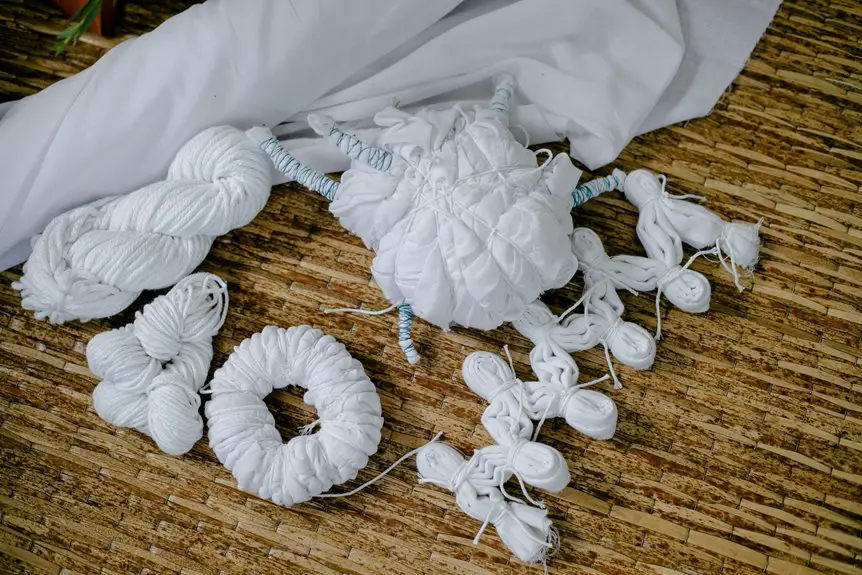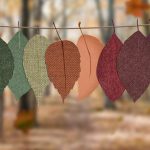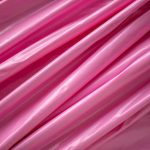You can create vibrant tie-dye designs using low water immersion dyeing, a method that saves water by submerging fabric just enough to stay wet. This technique gives you richer colors and faster drying while reducing waste and mess. You’ll use fiber-reactive dyes, soda ash, and carefully apply dye to folded fabric for sharp patterns. Keep your fabric damp, not soaked, to enhance color depth. If you want to master this eco-friendly approach and perfect your patterns, there’s more to discover.
Table of Contents
Key Takeaways
- Low water immersion dyeing uses minimal water to keep fabric just wet, allowing direct dye penetration and reducing waste.
- This technique produces richer, more vibrant colors due to concentrated dye solutions and faster dye absorption.
- Fabric is folded and tightly bound, then dye is carefully applied to specific areas for controlled, sharp patterns.
- A shallow container and precise dye application tools help maintain dye concentration and minimize mess.
- Wrapping dyed fabric in plastic retains moisture during setting, enhancing color depth through extended oxidation time.
Understanding Low Water Immersion Dyeing Techniques
Anyone exploring textile dyeing will find low water immersion techniques both efficient and eco-friendly. You’ll use less water by submerging fabric just enough to keep it wet, not soaked. This approach lets dyes penetrate fibers more directly, reducing waste.
Instead of large vats, you work with smaller containers or trays, controlling dye concentration and placement easily. You’ll also notice quicker drying times and less mess, since excess water isn’t involved.
Preparing your fabric carefully—folding or twisting it—helps create unique patterns with minimal water. By mastering this method, you control the dye process precisely, making your tie-dye projects more sustainable without sacrificing creativity.
It’s a smart way to get vibrant colors while conserving resources.
Benefits of Using Less Water in Tie-Dye
Using less water in tie-dye not only saves resources but also enhances your control over the dyeing process.
When you use minimal water, the dye concentrates more, resulting in richer, more vibrant colors that pop on your fabric. You’ll also notice shorter dyeing times since less water means the dye penetrates fibers faster.
Plus, using less water reduces mess and cleanup, making your workspace easier to manage. Environmentally, you’re cutting down on water waste and preventing excess dye runoff, which helps protect local waterways.
This method also lowers your overall costs by reducing water and dye consumption. By opting for low water immersion dyeing, you take a more sustainable, efficient, and creative approach to tie-dye that benefits both you and the planet.
Essential Materials and Preparation Steps
Before diving into low water immersion dyeing, gather the right materials and prepare your workspace carefully to guarantee the finest results. You’ll need fiber-reactive dyes, soda ash fixer, a large shallow container, and a spray bottle or dropper to apply the dye with precision.
Choose natural fiber fabrics like cotton or rayon for maximum dye absorption. Wear gloves and protect your surface with plastic or newspaper to avoid stains. Pre-wash your fabric to remove sizing and wrinkles, allowing the dye to penetrate evenly.
Soak the fabric briefly in soda ash solution to fix the dye better. Arrange your workspace near a sink or outdoors for easy cleanup. Having these essentials ready guarantees your low water immersion dyeing process goes smoothly and yields vibrant, lasting colors.
Step-by-Step Guide to Creating Low Water Tie-Dye Designs
Start by folding and securing your fabric to create striking patterns with minimal water. This step is essential for controlling where the dye will penetrate.
Begin by folding and securing fabric to shape bold, water-efficient dye patterns precisely.
Next, prepare your dye solution with a small amount of water to concentrate the colors. Then, apply the dye carefully to the fabric, ensuring you target specific folds and creases for bold effects.
Finally, wrap your fabric in plastic to keep moisture in and let it set.
- Fold and bind fabric tightly using rubber bands or string.
- Mix dye with minimal water for concentrated color.
- Apply dye selectively to exposed fabric areas.
- Wrap fabric in plastic and let it sit for several hours.
Following these steps will help you create vibrant low water tie-dye patterns efficiently.
Tips for Enhancing Color Vibrancy and Pattern Control
Once you’ve mastered the basic steps of low water tie-dye, you can focus on enhancing the vibrancy of your colors and gaining more control over your patterns.
To boost color intensity, use high-quality fiber-reactive dyes and keep your fabric damp but not soaked when applying the dye. This helps the dye absorb evenly without bleeding.
Control your patterns by carefully folding and tightly binding your fabric; the tighter the bind, the sharper the contrast between dyed and undyed areas. Experiment with different folding techniques to create unique designs.
Also, let your dyed fabric sit longer in a plastic bag to deepen the color through oxidation. Finally, rinse gently with cold water to preserve vibrancy.
These tips help you create striking, well-defined low water tie-dye designs every time.
Frequently Asked Questions
How Does Low Water Immersion Dyeing Impact Fabric Softness After Washing?
You’ll notice that low water immersion dyeing helps maintain fabric softness after washing since it uses less water and gentler handling, preventing stiffness and preserving the fabric’s natural feel compared to traditional dyeing methods.
Can Low Water Immersion Dyeing Be Used on Synthetic Fabrics?
You can use low water immersion dyeing on synthetic fabrics, but you’ll need special dyes designed for them. It works best with natural fibers, so synthetic materials might not absorb colors as vibrantly or evenly.
What Are the Environmental Disposal Guidelines for Dye Wastewater?
Did you know textile dyeing wastewater can contain up to 50% of unused dye? You should treat and neutralize it before disposal, comply with local regulations, and avoid releasing toxic chemicals into waterways to protect the environment.
How Long Do Low Water Immersion Tie-Dye Patterns Typically Last?
You can expect your tie-dye patterns to last several years if you properly set the dye and care for the fabric. Avoid harsh detergents and prolonged sun exposure to keep colors vibrant and patterns sharp.
Is Low Water Immersion Dyeing Suitable for Commercial-Scale Production?
You can use low water immersion dyeing for commercial-scale production, but you’ll need precise control over water and dye to guarantee consistency. It’s efficient but might require specialized equipment to handle larger batches smoothly.
- Does Chiffon Fabric Stink - July 15, 2025
- Does Chiffon Fabric Affect the Economy - July 15, 2025
- Does Cotton Fabric Have a Nap - July 15, 2025







